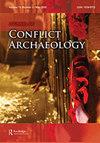为从未到来的战争做准备;对20世纪60年代一栋公寓楼内的避难所的检查
IF 0.6
0 ARCHAEOLOGY
引用次数: 1
摘要
冷战不仅影响了苏联和美国,还直接或间接地影响了世界其他地区。这种东西方之间的冲突形成了20世纪下半叶,它以物质遗产和思维方式的形式产生的影响是我们当代社会的组成部分。在瑞典,这是一个位于北约和华沙条约两个军事联盟之间的中立国,由于该国的中立政策,这种冲突是日常生活的一部分。因此,自拿破仑战争结束以来一直保持中立的瑞典被迫转向国内,依靠自己的能力和自力更生。可以说,瑞典从来没有真正的中立,如果冲突爆发,有迹象表明瑞典准备站在北约一边(Zetterberg 2007;Karlsson 1995,38 - 40)。这一事实也反映在瑞典当代的外交政策中,该国正在同北约组织进行军事演习,瑞典也参与联合军事行动。这种伙伴关系的一个例子是瑞典在2014年参与利比亚的行动,瑞典与北约合作保护该国领空的禁飞区(Doeser 2014, 196-213)。然而,瑞典中立政策的一个后果是冷战时期瑞典社会各方面的军事和民间动员。据估计,瑞典是在军事综合体上花费人均国民生产总值最多的国家之一(Zetterberg 2007;Forsvarsmakten 2021)。军事准备采取了多种形式和形式,但瑞典在军事上的支出可能是这种重整军备的主要例子。这样做的目的是为了让瑞典能够阻止,或者至少推迟地面入侵。正是由于重整军备的目标和中立政策,瑞典充分利用了强制性兵役,发展了强大的空军,并采取措施实现了自己的核计划(Jonter 2008, 61-65;Axelsson et al. 2018)。本文章由计算机程序翻译,如有差异,请以英文原文为准。
Preparation for the war which never came; the examination of a shelter inside an apartment building from the 1960’s
The Cold War did not only affect the USSR and the USA, since it also influenced the rest of the world, directly as well as indirectly. This conflict between West and East formed the second half of the 20 century, and its effects in the form of material remains and mindsets are integrated parts of our contemporary society. In Sweden, which was a neutral country located between the two military alliances, NATO and the Warsaw Pact, this conflict was a part of daily life due to the country’s policy of neutrality. Sweden, which had remained neutral ever since the end of the Napoleonic Wars was, therefore forced to turn inward and rely on its own capabilities and selfreliance. It could be argued that Sweden was never truly neutral and if a conflict had broken out, there are signs which indicate that Sweden was prepared to side with NATO (Zetterberg 2007; Karlsson 1995, 38–40). This fact is something which echoes also in Sweden’s contemporary foreign policy, where the country is taking part in military exercises with NATO, and where Sweden is also involved in joint military operations. An example of this partnership was Sweden’s involvement in Libya in 2014, an operation where Sweden worked together with NATO to safe-guard the no-fly zone over the nation’s airspace (Doeser 2014, 196–213). However, one consequence of the Swedish policy of neutrality was the military and civil mobilization of every aspect of the Swedish society during the Cold War period. It is estimated that Sweden was one of the nations which spent most per capita of its GNP on its military complex (Zetterberg 2007; Försvarsmakten 2021). The military preparation took many shapes and forms, but Sweden’s spending on its military is perhaps the primary example of this rearmament. The goal was that Sweden would be able to either withhold, or at least, delay a ground invasion. It was due to the goal of rearmament and the policy of neutrality that Sweden made full use of the mandatory military service, developed a strong air force, and took steps towards its own nuclear programme (Jonter 2008, 61–65; Axelsson et al. 2018).
求助全文
通过发布文献求助,成功后即可免费获取论文全文。
去求助
来源期刊

Journal of Conflict Archaeology
ARCHAEOLOGY-
CiteScore
0.80
自引率
50.00%
发文量
8
期刊介绍:
The Journal of Conflict Archaeology is an English-language journal devoted to the battlefield and military archaeology and other spheres of conflict archaeology, covering all periods with a worldwide scope. Additional spheres of interest will include the archaeology of industrial and popular protest; contested landscapes and monuments; nationalism and colonialism; class conflict; the origins of conflict; forensic applications in war-zones; and human rights cases. Themed issues will carry papers on current research; subject and period overviews; fieldwork and excavation reports-interim and final reports; artifact studies; scientific applications; technique evaluations; conference summaries; and book reviews.
 求助内容:
求助内容: 应助结果提醒方式:
应助结果提醒方式:


